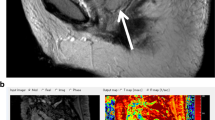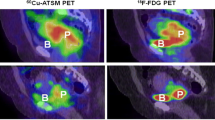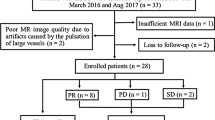Abstract
Objectives
To investigate the value of blood oxygenation level-dependent (BOLD) magnetic resonance imaging (MRI) as a predictor of therapeutic response in cervical cancer patients undergoing concurrent chemoradiotherapy (CCRT).
Methods
Thirty consecutive patients with biopsy-proven cervical cancer were examined by BOLD MRI before (preTx) and after CCRT (postTx). The R2* value (s-1) was calculated in the tumour and normal myometrium for preTx and postTx studies. Final tumour responses, as determined by changes of tumour size or volume on MRI, were correlated with tumour R2* values at preTx.
Results
The mean R2* values of tumours at preTx (21.1) were significantly lower than those at postTx (39.4 s-1) (p < 0.001), while those of normal myometrium were similar between preTx and postTx (p = 0.363). At preTx, tumour R2* values showed significantly negative correlation with final tumour size response (p = 0.022, Spearman’s coefficient = -0.415). However, tumour R2* values at preTx were not associated with final tumour volume response (p = 0.069).
Conclusions
BOLD MRI at 3 T, as an imaging biomarker, may have the potential to evaluate therapeutic response in cervical cancers. The association between BOLD MRI findings and CCRT responses warrants further validation.
Key points
• Hypoxia in cervical cancer is an independent risk factor
• BOLD MRI reflect oxygenation status of tissue adjacent to perfused microvessels
• Pretreatment tumour R2* reveal negative correlation with final tumour size response
• Accurate oxygenation assessment in cervical cancer may help clinical decision making


Similar content being viewed by others
Abbreviations
- BOLD:
-
Blood oxygenation-level dependent
- CCRT:
-
Concurrent chemoradiotherapy
- DCE:
-
Dynamic contrast enhanced
- PreTx:
-
Before treatment
- PostTx:
-
Post treatment
- mFFE:
-
Multiple fast field echo
- SCC:
-
Squamous cell carcinoma
- FIGO:
-
Federation of International Gynecology and Obstetrics
- LN:
-
Lymph node
- EBRT:
-
External beam radiotherapy
- ICR:
-
Intracavitary brachytherapy
References
Eisenhauer EA, Therasse P, Bogaerts J et al (2009) New response evaluation criteria in solid tumours: revised RECIST guideline (version 1.1). Eur J Cancer 45:228–247
Pickles MD, Gibbs P, Lowry M, Turnbull LW (2006) Diffusion changes precede size reduction in neoadjuvant treatment of breast cancer. Magn Reson Imaging 24:843–847
Britten RA, Evans AJ, Allalunis-Turner MJ, Franko AJ, Pearcey RG (1996) Intratumoral heterogeneity as a confounding factor in clonogenic assays for tumour radioresponsiveness. Radiother Oncol 39:145–153
Fyles A, Milosevic M, Hedley D et al (2002) Tumor hypoxia has independent predictor impact only in patients with node-negative cervix cancer. J Clin Oncol 20:680–687
Bentzen L, Keiding S, Nordsmark M et al (2003) Tumour oxygenation assessed by 18 F-fluoromisonidazole PET and polarographic needle electrodes in human soft tissue tumours. Radiother Oncol 67:339–344
Mayer A, Hockel M, Vaupel P (2006) Endogenous hypoxia markers in locally advanced cancers of the uterine cervix: reality or wishful thinking? Strahlenther Onkol 182:501–510
Loncaster JA, Carrington BM, Sykes JR et al (2002) Prediction of radiotherapy outcome using dynamic contrast enhanced MRI of carcinoma of the cervix. Int J Radiat Oncol Biol Phys 54:759–767
Neugarten J (2012) Renal BOLD-MRI and assessment for renal hypoxia. Kidney Int 81:613–614
Halle C, Andersen E, Lando M et al (2012) Hypoxia-induced gene expression in chemoradioresistant cervical cancer revealed by dynamic contrast-enhanced MRI. Cancer Res 72:5285–5295
Andersen EK, Hole KH, Lund KV et al (2013) Pharmacokinetic parameters derived from dynamic contrast enhanced MRI of cervical cancers predict chemoradiotherapy outcome. Radiother Oncol 107:117–122
Hallac RR, Ding Y, Yuan Q et al (2012) Oxygenation in cervical cancer and normal uterine cervix assessed using blood oxygenation level-dependent (BOLD) MRI at 3 T. NMR Biomed 25:1321–1330
Oh D, Lee JE, Huh SJ et al (2013) Prognostic significance of tumor response as assessed by sequential 18 F-fluorodeoxyglucose-positron emission tomography/computed tomography during concurrent chemoradiation therapy for cervical cancer. Int J Radiat Oncol Biol Phys 87:549–554
Vaupel P, Mayer A (2007) Hypoxia in cancer: significance and impact on clinical outcome. Cancer Metastasis Rev 26:225–239
Wakefield JC, Downey K, Kyriazi S, deSouza NM (2013) New MR techniques in gynecologic cancer. AJR Am J Roentgenol 200:249–260
Hoskin PJ, Carnell DM, Taylor NJ et al (2007) Hypoxia in prostate cancer: correlation of BOLD-MRI with pimonidazole immunohistochemistry-initial observations. Int J Radiat Oncol Biol Phys 68:1065–1071
Chen CM, Hou BL, Holodny AI (2008) Effect of age and tumor grade on BOLD functional MR imaging in preoperative assessment of patients with glioma. Radiology 248:971–978
Jiang L, Weatherall PT, McColl RW, Tripathy D, Mason RP (2013) Blood oxygenation level-dependent (BOLD) contrast magnetic resonance imaging (MRI) for prediction of breast cancer chemotherapy response: a pilot study. J Magn Reson Imaging 37:1083–1092
O'Connor JP, Naish JH, Parker GJ et al (2009) Preliminary study of oxygen-enhanced longitudinal relaxation in MRI: a potential novel biomarker of oxygenation changes in solid tumors. Int J Radiat Oncol Biol Phys 75:1209–1215
Nam H, Huh SJ, Ju SG et al (2012) 18 F-fluorodeoxyglucose positron emisson tomography/computed tomography guided conformal brachytherapy for cervical cancer. Int J Radiat Oncol Biol Phys 84:e29–e34
Kim HS, Kim CK, Park BK, Huh SJ, Kim B (2013) Evaluation of therapeutic response to concurrent chemoradiotherapy in patients with cervical cancer using diffusion-weighted MR imaging. J Magn Reson Imaging 37:187–193
Min JH, Kim CK, Park BK, Kim E, Kim B (2011) Assessment of renal lesions with blood oxygenation level-dependent MRI at 3 T: preliminary experience. AJR Am J Roentgenol 197:W489–W494
Prasad PV (2006) Evaluation of intra-renal oxygenation by BOLD MRI. Nephron Clin Pract 103:c58–c65
Lyng H, Sundfor K, Trope C, Rofstad EK (2000) Disease control of uterine cervical cancer: relationships to tumor oxygen tension, vascular density, cell density, and frequency of mitosis and apoptosis measured before treatment and during radiotherapy. Clin Cancer Res 6:1104–1112
Hockel M, Schlenger K, Hockel S, Vaupel P (1999) Hypoxic cervical cancers with low apoptotic index are highly aggressive. Cancer Res 59:4525–4528
Harry VN (2010) Novel imaging techniques as response biomarkers in cervical cancer. Gynecol Oncol 116:253–261
Li LP, Halter S, Prasad PV (2008) Blood oxygen level-dependent MR imaging of the kidneys. Magn Reson Imaging Clin N Am 16:613–625, viii
Wagenaar HC, Trimbos JB, Postema S et al (2001) Tumor diameter and volume assessed by magnetic resonance imaging in the prediction of outcome for invasive cervical cancer. Gynecol Oncol 82:474–482
Nam H, Park W, Huh SJ et al (2007) The prognostic significance of tumor volume regression during radiotherapy and concurrent chemoradiotherapy for cervical cancer using MRI. Gynecol Oncol 107:320–325
Saida T, Tanaka YO, Ohara K et al (2010) Can MRI predict local control rate of uterine cervical cancer immediately after radiation therapy? Magn Reson Med Sci 9:141–148
Acknowledgments
The scientific guarantor of this publication is Seung Jae Huh. The authors of this manuscript declare no relationships with any companies, whose products or services may be related to the subject matter of the article. The authors state that this work has not received any funding. Sookyoung Woo, PhD kindly provided statistical advice for this manuscript. Institutional Review Board approval was obtained. Written informed consent was obtained from all subjects (patients) in this study. Approval from the institutional animal care committee was not required because this study was on human subjects. None of the study subjects or cohorts have been previously reported in any studies. Methodology: prospective, diagnostic or prognostic study, performed at one institution.
Author information
Authors and Affiliations
Corresponding author
Rights and permissions
About this article
Cite this article
Kim, C.K., Park, S.Y., Park, B.K. et al. Blood oxygenation level-dependent MR imaging as a predictor of therapeutic response to concurrent chemoradiotherapy in cervical cancer: a preliminary experience. Eur Radiol 24, 1514–1520 (2014). https://doi.org/10.1007/s00330-014-3167-0
Received:
Revised:
Accepted:
Published:
Issue Date:
DOI: https://doi.org/10.1007/s00330-014-3167-0




